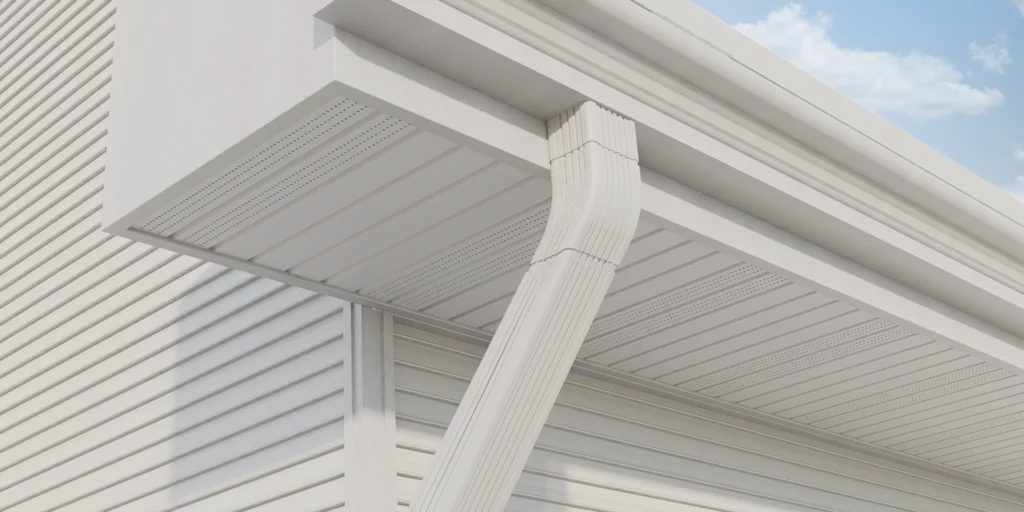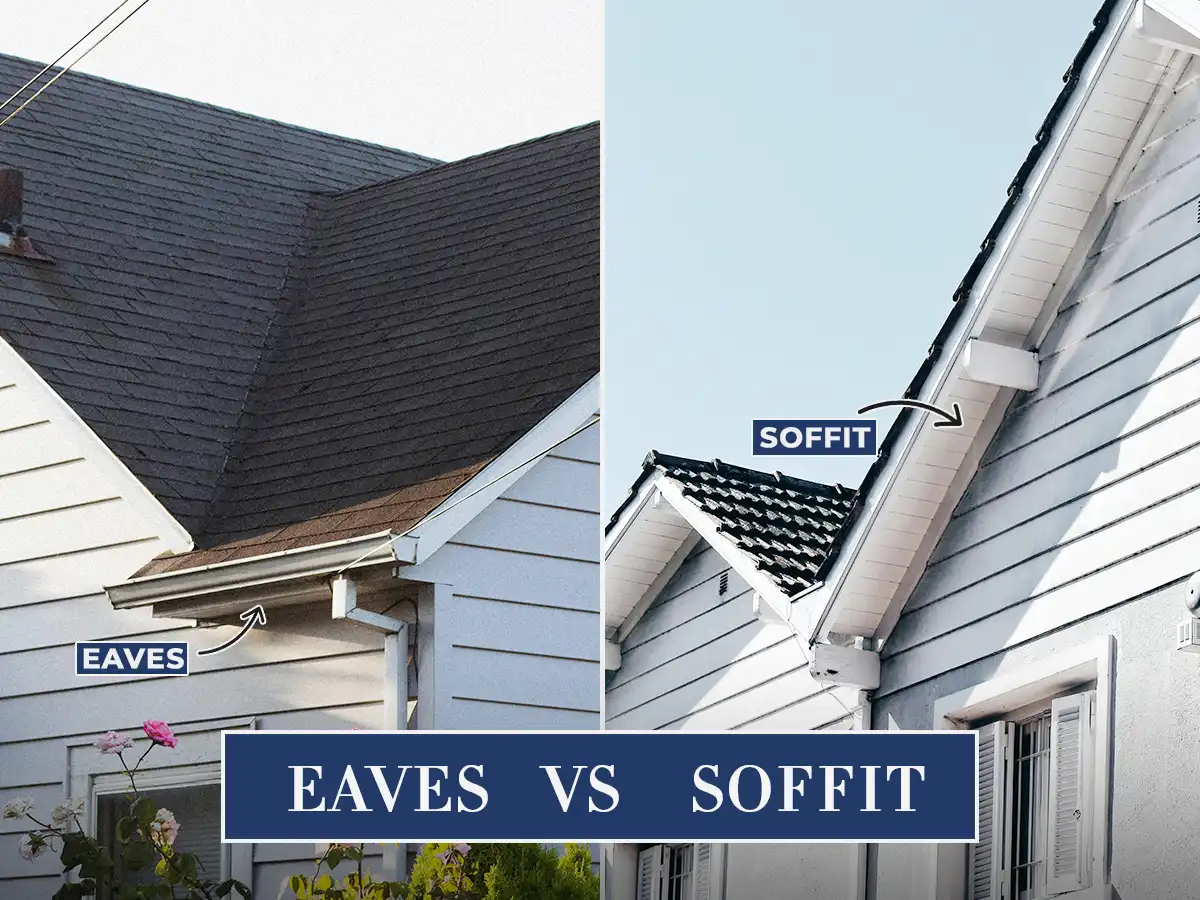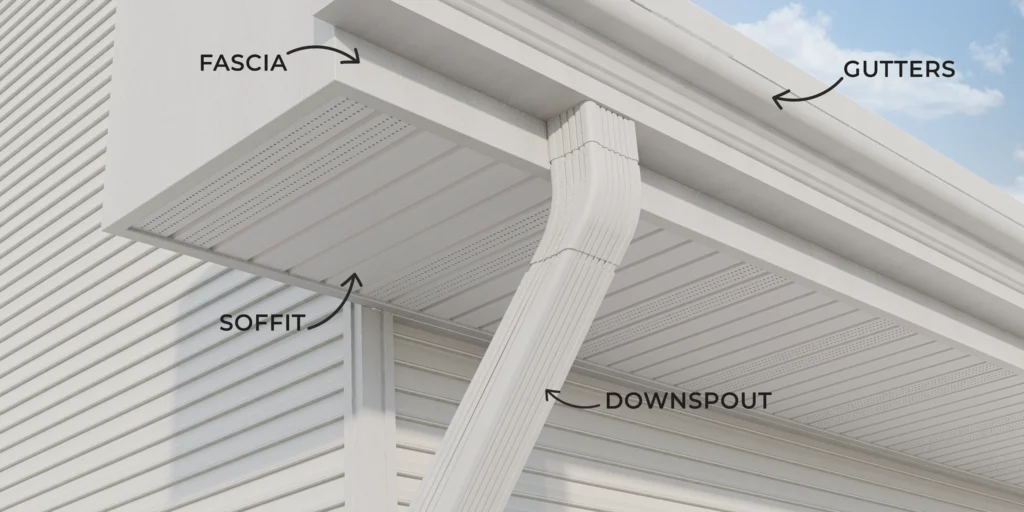
Eaves and soffits are essential parts of a roof structure, enhancing both functionality and aesthetics. They help protect a home from external elements while improving ventilation and durability.
Although closely related, eaves and soffits serve different purposes. Eaves are the roof edges that extend beyond the exterior walls, providing shade and shielding the walls from rain and snow. They also help with ventilation by allowing airflow into the attic.
Soffits are located underneath the eaves, connecting the roof overhang to the exterior wall. They are usually ventilated to regulate attic airflow, prevent moisture buildup, and reduce the risk of mold and wood rot.

While eaves and soffits are both integral to a roofing system, they have distinct differences in structure, function, and design.
The eave is the part of the roof that extends beyond the walls of a building, creating an overhang. Its primary function is to provide shade, protect walls from rain, and help direct water away from the structure to prevent potential damage. Eaves are visible from the outside, adding to the architectural appeal of a home.
They are commonly made from wood, metal, or composite materials, offering both durability and aesthetic flexibility. While eaves do not have direct ventilation, they work in conjunction with soffits to support airflow and moisture control.
The soffit is located underneath the eave, covering the exposed underside to create a finished and polished look. It plays a crucial role in home ventilation by allowing air to flow into the attic, preventing moisture buildup, and reducing the risk of mold and wood rot.
Unlike eaves, soffits are less visible since they are installed underneath, but they still contribute to the overall aesthetics of a home’s exterior. Soffits come in various materials, including vinyl, aluminum, wood, and fiber cement. Many soffits are designed with vents to enhance airflow, ensuring proper circulation and preventing heat buildup in the attic.

Eaves shield the walls from rain, reducing the risk of water damage. Soffits prevent moisture buildup, reducing mold and mildew growth.
Soffits allow fresh air to circulate in the attic, preventing heat buildup in summer and condensation in winter.
Both elements contribute to the home’s curb appeal. Eaves provide architectural depth, while soffits create a polished look.
Offers a classic and elegant appearance that enhances traditional home designs. However, it requires frequent maintenance, including sealing or painting, to protect against moisture, rot, and insect damage. While beautiful, it may not be ideal for areas with high humidity or extreme weather conditions.
A budget-friendly and low-maintenance option that resists moisture, warping, and decay. It is available in various colors and textures, allowing homeowners to customize their exterior aesthetics. Vinyl is particularly suitable for humid or rainy climates, but it may become brittle over time in extremely cold temperatures.
A lightweight yet highly durable material that is resistant to rust, corrosion, and harsh weather conditions. It provides excellent longevity with minimal upkeep and is ideal for coastal or high-humidity areas where metal durability is crucial. However, aluminum can dent easily and may require repainting over time.
Known for its exceptional strength, fire resistance, and long lifespan, fiber cement is a great choice for homeowners seeking maximum protection. It can withstand extreme temperatures, pests, and moisture damage, making it highly durable. However, it is heavier than other materials and may require professional installation due to its density.
Open Eaves The open eaves allowed for exposed rafters beneath the roof overhang, giving it a timeless, old-school feel The style, which is typical of heritage or craftsman-style homes, also brings a rustic charm and natural ventilation.
Closed Eaves have soffits or fascia housing the bottom of the roof overhang, contributing to a tidy and contemporary aesthetic.
Their entire surface will be fully enclosed with a finished underside, giving a seamless, protective edge to the roofline.
Exposed Eaves accentuate decorative rafters that are part of a home’s architectural design. They are frequently found in craftsman, Mediterranean and chalet-style houses to add detail and visual depth.
Vented SoffitsEnsuring proper airflow minimizes mold growth risk and safeguards the roof structure by keeping temperatures balanced. These soffits are perfect for homes needing extra ventilation to enhance energy efficiency and extend the roof's lifespan.
Non-vented soffits, also known as solid soffits, do not have perforations and are used when alternative ventilation systems, such as ridge vents or gable vents, are already in place. They provide a seamless and uniform look while still protecting the roof and eaves from weather damage.
Aluminum soffits are a popular choice due to their lightweight yet highly durable properties. They are resistant to rust, corrosion, and harsh weather conditions, making them a long-lasting option for various climates. Additionally, aluminum soffits require minimal maintenance, making them a practical and reliable choice for homeowners seeking durability and protection.
They are resistant to moisture, which helps prevent rot and decay, making them ideal for humid and wet climates. Available in a variety of colors and styles, vinyl soffits allow homeowners to enhance the appearance of their home while ensuring proper protection and longevity.
No, eaves and soffits are different but closely related. Eaves are the roof edges that extend beyond the walls, providing shade and protection from rain. Soffits, on the other hand, are the underside of the eaves, helping with ventilation and offering a finished look.
The underside of the eaves is called the soffit. It covers the exposed rafters and often includes ventilation to regulate airflow in the attic.
In Australia, eaves are typically made from timber, fiber cement, aluminum, or vinyl. Fiber cement is popular due to its fire resistance and durability in extreme weather conditions.
Older houses, particularly those built before the 1990s, may have asbestos-containing eaves or soffits, commonly made from asbestos cement sheeting. A professional asbestos assessment is recommended before renovation or replacement.
Asbestos soffits often appear as flat, cement-like sheets with a smooth or slightly textured surface. They may have small nail or rivet holes and sometimes show signs of aging, such as cracks or discoloration. Only professional testing can confirm asbestos presence.
The material under the roof eaves is called the soffit, which can be made from vinyl, aluminum, wood, or fiber cement. Vented soffits help with attic ventilation, while solid soffits provide a seamless finish.
Eaves and soffits play crucial roles in a home’s roofing system. While eaves protect from weather, soffits support ventilation. Choosing the right materials and design enhances both functionality and aesthetics. Understanding their differences helps homeowners decide on a well-structured and durable roof.
Read also -What are Eaves, What is a Gable Roof, Roof Types in Australia,